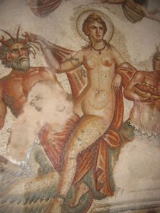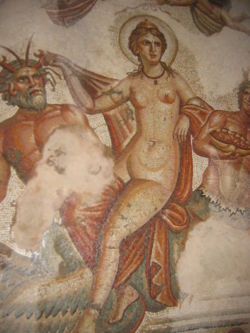
Bulla Regia
Encyclopedia

Archaeological site
An archaeological site is a place in which evidence of past activity is preserved , and which has been, or may be, investigated using the discipline of archaeology and represents a part of the archaeological record.Beyond this, the definition and geographical extent of a 'site' can vary widely,...
in northwestern Tunisia
Tunisia
Tunisia , officially the Tunisian RepublicThe long name of Tunisia in other languages used in the country is: , is the northernmost country in Africa. It is a Maghreb country and is bordered by Algeria to the west, Libya to the southeast, and the Mediterranean Sea to the north and east. Its area...
, a former Roman
Roman Empire
The Roman Empire was the post-Republican period of the ancient Roman civilization, characterised by an autocratic form of government and large territorial holdings in Europe and around the Mediterranean....
city near modern Jendouba
Jendouba
Jendouba is a large city in northwestern Tunisia, and capital of the Jendouba Governorate. It is an important crossroads with many road links to other towns such as El Kef, Tabarka, Ain Draham and Béja. The main economic activity is agriculture....
. It is noted for its Hadrianic-era semi-subterranean housing, a protection from the fierce heat and effects of the sun. Many of the mosaic
Mosaic
Mosaic is the art of creating images with an assemblage of small pieces of colored glass, stone, or other materials. It may be a technique of decorative art, an aspect of interior decoration, or of cultural and spiritual significance as in a cathedral...
floors have been left in situ; others may be seen at the Bardo Museum, Tunis
Tunis
Tunis is the capital of both the Tunisian Republic and the Tunis Governorate. It is Tunisia's largest city, with a population of 728,453 as of 2004; the greater metropolitan area holds some 2,412,500 inhabitants....
. There is also a small museum connected with the site.
Origins and Early History
The BerberBerber people
Berbers are the indigenous peoples of North Africa west of the Nile Valley. They are continuously distributed from the Atlantic to the Siwa oasis, in Egypt, and from the Mediterranean to the Niger River. Historically they spoke the Berber language or varieties of it, which together form a branch...
origins of Bulla Regia probably pre-dated its Punic culture: imported Greek ceramics of the fourth century BCE have been found; it came under the hegemony
Hegemony
Hegemony is an indirect form of imperial dominance in which the hegemon rules sub-ordinate states by the implied means of power rather than direct military force. In Ancient Greece , hegemony denoted the politico–military dominance of a city-state over other city-states...
of Carthage
Carthage
Carthage , implying it was a 'new Tyre') is a major urban centre that has existed for nearly 3,000 years on the Gulf of Tunis, developing from a Phoenician colony of the 1st millennium BC...
during the third century, when inscriptions reveal that the inhabitants venerated Baal Hammon and buried their dead in urns, Punic style. A capital from a temple of Tanit
Tanit
Tanit was a Phoenician lunar goddess, worshipped as the patron goddess at Carthage. Tanit was worshiped in Punic contexts in the Western Mediterranean, from Malta to Gades into Hellenistic times. From the fifth century BCE onwards Tanit is associated with that of Baal Hammon...
is preserved at the site's museum.
Later History
Broadly speaking, it was part of the territory conquered for Rome in 203 BCE by Scipio AfricanusScipio Africanus
Publius Cornelius Scipio Africanus , also known as Scipio Africanus and Scipio the Elder, was a general in the Second Punic War and statesman of the Roman Republic...
, but in 156 BCE it became the capital of the Numidia
Numidia
Numidia was an ancient Berber kingdom in part of present-day Eastern Algeria and Western Tunisia in North Africa. It is known today as the Chawi-land, the land of the Chawi people , the direct descendants of the historical Numidians or the Massyles The kingdom began as a sovereign state and later...
n king Massinissa, who "recovered the lands of his ancestors", according to an inscription, and gave to the site its epithet Regia ("Royal"); later, one of his sons had a residence in the city. Under the Numidians, a regularized orthogonal grid street plan in the Hellenistic manner was imposed on at least part of the earlier irregular system of alleys and insulae
Insulae
In Roman architecture, an insula was a kind of apartment building that housed most of the urban citizen population of ancient Rome, including ordinary people of lower- or middle-class status and all but the wealthiest from the upper-middle class...
(Thébaut). The Romans assumed direct control in 46 BCE, when Julius Caesar
Julius Caesar
Gaius Julius Caesar was a Roman general and statesman and a distinguished writer of Latin prose. He played a critical role in the gradual transformation of the Roman Republic into the Roman Empire....
organized the province of Africa Nova and rewarded the (perhaps simply neutral) conduct of Bulla Regia in the Civil Wars by making it a free city. Under Hadrian, it was refounded as Colonia Aelia Hadriana Augusta Bulla Regia, giving its citizens full Romanitas
Romanitas
Romanità also termed Romanitas in English referring to "Roman-ness" or the Roman ideal the refers to an immiscibly Latin culture of the Roman Empire. Cicero contributed much to the notion....
.
Its small amphitheatre, the subject of a reproach in a sermon of Augustine of Hippo
Augustine of Hippo
Augustine of Hippo , also known as Augustine, St. Augustine, St. Austin, St. Augoustinos, Blessed Augustine, or St. Augustine the Blessed, was Bishop of Hippo Regius . He was a Latin-speaking philosopher and theologian who lived in the Roman Africa Province...
, retains the crispness of its edges and steps because it lay buried until 1960-61. To this day, the Roman Catholic Church
Roman Catholic Church
The Catholic Church, also known as the Roman Catholic Church, is the world's largest Christian church, with over a billion members. Led by the Pope, it defines its mission as spreading the gospel of Jesus Christ, administering the sacraments and exercising charity...
retains this site as a bishopric
Diocese
A diocese is the district or see under the supervision of a bishop. It is divided into parishes.An archdiocese is more significant than a diocese. An archdiocese is presided over by an archbishop whose see may have or had importance due to size or historical significance...
, a titular see
Titular see
A titular see in various churches is an episcopal see of a former diocese that no longer functions, sometimes called a "dead diocese". The ordinary or hierarch of such a see may be styled a "titular bishop", "titular metropolitan", or "titular archbishop"....
, Bullensium Regiorum.
Description
In the unique domusDomus
In ancient Rome, the domus was the type of house occupied by the upper classes and some wealthy freedmen during the Republican and Imperial eras. They could be found in almost all the major cities throughout the Roman territories...
architecture developed in the city, a ground-level storey, open to the warming winter sun, stood above a subterranean level, built round a two-story atrium
Atrium (architecture)
In modern architecture, an atrium is a large open space, often several stories high and having a glazed roof and/or large windows, often situated within a larger multistory building and often located immediately beyond the main entrance doors...
. Open-bottomed terracotta bottle-shapes were built into vaulting. Water sprinkled on the floors brought the colors of the mosaics to life while they provided cooling by evaporation.
.jpg)
Basilica
The Latin word basilica , was originally used to describe a Roman public building, usually located in the forum of a Roman town. Public basilicas began to appear in Hellenistic cities in the 2nd century BC.The term was also applied to buildings used for religious purposes...
, with an apse at its head, a transept and dependent spaces opening into what would be the nave
Nave
In Romanesque and Gothic Christian abbey, cathedral basilica and church architecture, the nave is the central approach to the high altar, the main body of the church. "Nave" was probably suggested by the keel shape of its vaulting...
if it were a church, has been instanced (Thébert) as an example of the conjunction between public architecture and the domus
Domus
In ancient Rome, the domus was the type of house occupied by the upper classes and some wealthy freedmen during the Republican and Imperial eras. They could be found in almost all the major cities throughout the Roman territories...
of the ruling class in the fourth century, spaces soon to be Christianized
Christianization
The historical phenomenon of Christianization is the conversion of individuals to Christianity or the conversion of entire peoples at once...
as churches and cathedrals.
The subtle colors and shading and the modelling of three-dimensional forms of the finest mosaics at Bulla Regia are not surpassed by any in North Africa, where the Roman art of mosaic floors reached its fullest development. The mosaic of a halo
Halo (religious iconography)
A halo is a ring of light that surrounds a person in art. They have been used in the iconography of many religions to indicate holy or sacred figures, and have at various periods also been used in images of rulers or heroes...
ed Amphitrite
Amphitrite
In ancient Greek mythology, Amphitrite was a sea-goddess and wife of Poseidon. Under the influence of the Olympian pantheon, she became merely the consort of Poseidon, and was further diminished by poets to a symbolic representation of the sea...
(House of Amphitrite) is often illustrated (above, right).
Decline and Destruction
After its season of flourishing, Bulla Regia was slowly degraded under Byzantine ruleByzantine Empire
The Byzantine Empire was the Eastern Roman Empire during the periods of Late Antiquity and the Middle Ages, centred on the capital of Constantinople. Known simply as the Roman Empire or Romania to its inhabitants and neighbours, the Empire was the direct continuation of the Ancient Roman State...
. As elsewhere in the Late Empire, the local aristocracy found themselves in a position to increase the extent of their houses at the expense of public space: the House of the Fisherman was adapted to link two separate insulae turning a thoroughfare into a dead end. Finally an earthquake destroyed Bulla Regia, collapsing its first floors into the subterranean floors.
Archaeological Discovery
Drifting sand protected the abandoned sites, which were forgotten until the first excavations were begun, in 1906, in part spurred by the destruction of the monumental entrance to the Roman city. The forum, surrounded by porticoes, was excavated in 1949-52. Its public basilicaBasilica
The Latin word basilica , was originally used to describe a Roman public building, usually located in the forum of a Roman town. Public basilicas began to appear in Hellenistic cities in the 2nd century BC.The term was also applied to buildings used for religious purposes...
had an apse
Apse
In architecture, the apse is a semicircular recess covered with a hemispherical vault or semi-dome...
at each end. As a cathedral it had a highly unusual cruciform baptismal font inserted the center of the rear (west end) of its nave (Jensen).
Further reading
The excavations at Bulla Regia were published as Les ruines de Bulla Regia, A. Besaouch, R. Hanoune, and Y. Thébert, Rome, 1977.External links
Website about Bulla Regia
Website about Bulla Regia
Virtual tourist site

